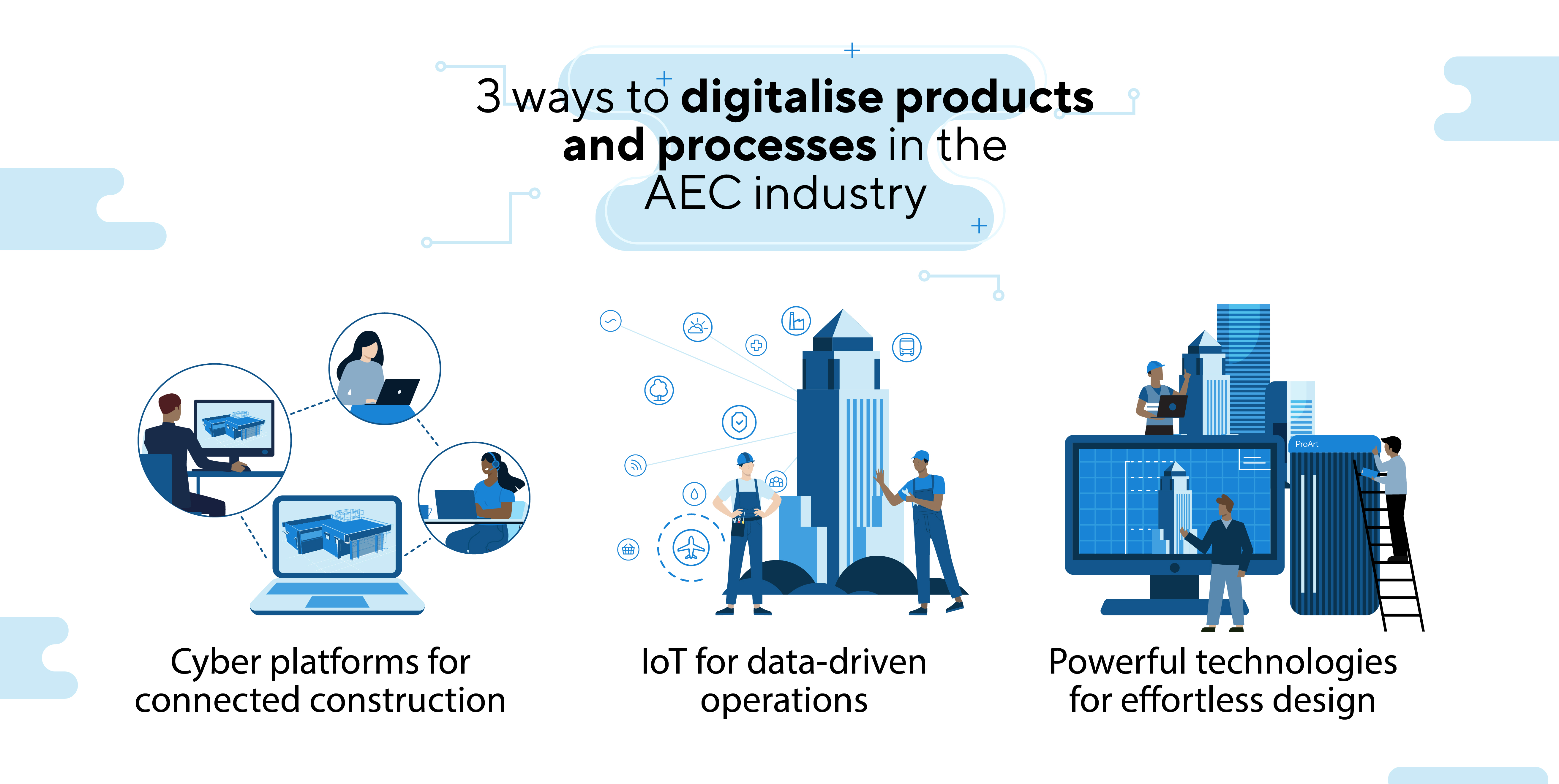Rethink your digital toolbox to overcome AEC industry challenges

The architecture, engineering, and construction (AEC) industry is projected to grow at a rapid pace, but pressure from labor shortages, supply chain disruptions, and high materials prices could moderate growth1. AEC projects are notoriously complex to manage and execute – bespoke projects and one-off designs defy process repetition and longer lead times and shortage of materials have led to project delays2. 51% of AEC leaders also see the war for top talent as the number two anticipated challenge3, a pervasive trend that exacerbates the industry’s issues.
According to McKinsey, the bulk of these challenges will be solved with technology4. Construction 4.0 is the manifestation of this – seeing the rapid development of digital technologies to boost decision-making, streamline management, and improve the quality of work in AEC. These advancements are projected to lead to US$950 million in cost savings in the global AEC industry in 20255 – but first, leaders need to be able to determine the promising digital tools that are worth the investment.

Digitalizing products and processes
Cyber platforms for connected construction

McKinsey’s analysis of the AEC industry shows a steady movement away from one-off and siloed tools towards connected construction platforms6. To truly succeed in digital transformation, AEC companies need to integrate their disparate project data, digital tools, and devices to maximize collaboration and empower AEC professionals to work seamlessly and in less time.
Currently, building information modelling (BIM) is widely used in the AEC industry to help architects, engineers, and managers to integrate the whole value chain, from planning and design to construction and renovation. BIM enables the creation of digital twins – 3D models that help all stakeholders to share data and remain aligned throughout the construction and lifecycle of built assets.
Devices like the ASUS ExpertBook B6 can help AEC companies to power industry leading software solutions like Revit, AutoCAD®, Microstation, and AllPlan. With immense power packed in a slim and flappable form, the ExpertBook B6 can handle complex workloads seamlessly across AEC disciplines. It helps users bring design concepts to life through BIM software like ArchiCAD and Lumion, effortlessly transition from 2D sketches to 3D modelling and printing via tools like Creo® and Solidworks®, and handle data-intensive applications for deeper insights and better decision-making. This is the edge that AEC companies need in today’s competitive market.
IoT for data-driven operations
Drilling deeper into the trends, the Internet of Things (IoT) is also emerging as a crucial technology for the AEC industry, especially in the management and operations phase. Smart buildings and IoT-enabled infrastructure increase the share of data, allowing engineers and managers real-time visibility into process flows during the construction phase and improve communication and real-time analytics across job sites, buildings and machines.
IoT components in AEC include sensors, tags, robots and drones – which may be complemented by artificial intelligence technologies like virtual and augmented reality to enhance human-machine performance. ASUS IoT solutions include cutting-edge industrial solutions like motherboards, intelligent edge computers and AI accelerators to support data-driven operations from office to construction grounds.
Powerful technologies for effortless design
A building’s lifecycle begins in the designer’s hands, so AEC leaders would be remiss to neglect improving the design experience for employees. Nowadays, effortless design is dependent on digital technologies – ones that can give designers the power to create full-blown graphics and 3D models with super resolution and powerful performance.
The ASUS ProArt Station PD5 fulfills these criteria. This remarkable GPU offers high-performance, NVIDIA® RTX™ A2000 12GB or NVIDIA® GeForce® RTX™ 3070 graphics, and AI-powered super-resolution technology. Creator-friendly design touches like ASUS Lumiwiz LED indicators, a tool-less hard drive tray and a power-button shield also ensures smooth workflow, greater productivity, and effortless design.
It’s time to digitalize the AEC industry
“Digital technologies can enable better collaboration, greater control of the value chain, and a shift towards more data-driven decision making7. These innovations will transform the way companies approach planning, design, construction, and operations. To move forward and through challenges, AEC companies will need to rethink their AEC toolbox – and fill it with digital tools that prioritise productivity, resilience, and collaboration.
- Windows 11 Pro - ASUS recommends Windows 11 Pro for business
- Up to 13th Gen Intel® Core™ i7 processor
- Up to NVIDIA® GeForce RTX™ 3060
- Tool-free chassis design
- Up to 128 GB memory
- 3 TB HDD + 2 TB SSD storage
- Two-way AI noise-canceling
- Windows 11 Pro - ASUS recommends Windows 11 Pro for business
- Up to 12th Intel® Core™ i7 processor
- Up to NVIDIA RTX A200 graphic cards
- 360° flip design
- Up to 128 GB memory
- Up to 4 TB SSD storage
- ISV- certificated
- MIL-STD 810H US military standard
- Windows 11 Pro - ASUS recommends Windows 11 Pro for business
- Up to 13th gen Intel® Core™ i9 processor
- Up to NVIDIA GeForce RTX™ 4070 or NVIDIA® RTX™ A4000 graphics
- Up to 128 GB memory
- Up to 4 TB HDD + 4 TB SSD storage
- Enhanced thermal system with multi-zone cooling design
- ISV certification
- Lumiwiz® Smart LED indicators
Related articles
- American Society of Civil Engineers, 2022: The first of several solid years for the AEC industry, https://www.asce.org/publications-and-news/civil-engineering-source/civil-engineering-magazine/issues/magazine-issue/article/2022/01/2022-the-first-of-several-solid-years-for-the-aec-industry
- Deloitte, 2023 Engineering and Construction Industry Outlook, https://www2.deloitte.com/us/en/pages/energy-and-resources/articles/engineering-and-construction-industry-trends.html
- Hinge Research Institute, The Top 5 Anticipated Business Challenges of Architecture, Engineering, and Construction Firms, https://hingemarketing.com/blog/story/the-top-5-anticipated-business-challenges-of-architecture-engineering-and-construction-firms
- McKinsey, Rise of the platform era: The next chapter in construction technology, https://www.mckinsey.com/industries/private-equity-and-principal-investors/our-insights/rise-of-the-platform-era-the-next-chapter-in-construction-technology
- Energy and Built Environment, Towards digital AEC industry through VDC and digital twin, https://www.sciencedirect.com/science/article/pii/S266612332100060X#bib0004
- McKinsey, Rise of the platform era: The next chapter in construction technology, https://www.mckinsey.com/industries/private-equity-and-principal-investors/our-insights/rise-of-the-platform-era-the-next-chapter-in-construction-technology
- McKinsey, The next normal in construction, https://www.mckinsey.com/~/media/McKinsey/Industries/Capital%20Projects%20and%20Infrastructure/Our%20Insights/The%20next%20normal%20in%20construction/The-next-normal-in-construction.pdf

